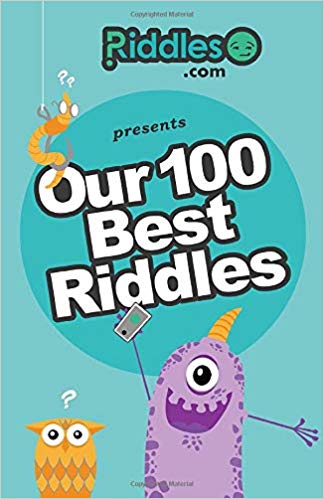Enter a keyword into the search box. The riddle search will check to see if the word is in the Title, Riddle, or Answer and return results if they exist.
"Pen" Riddles - Next 10 of 281.
Riddle:
Joe has ten coins totaling $1.19. From these coins, he cannot make exact change for a dollar, half-dollar, quarter, dime, or nickel.
What are the coins?
Answer: A half-dollar, a quarter, four dimes, and four pennies.
Riddle:
My only timepiece is a wall clock. One day I forgot to wind it and it stopped. I went to visit a friend whos watch is always correct, stayed awhile, and then went home. There I made a simple calculation and set the clock right.
How did I do this even though I had no watch on me to tell how long it took me to return from my friend's house?
Answer: Before I left, I wound the wall clock. When I returned, the change in time equaled how long it took to go to my friends house and return, plus the time I spent there. But I knew the latter because I looked at my friends watch when I arrived and left.
Subtracting the time of the visit from the time I was absent from my house, and dividing by 2, I obtained the time it took me to return home. I added this time to what my friend watch showed when I left, and set the sum on my wall clock.
Riddle:
A rogue pilot was about to bomb Germany! The commad was given, the hatch was opened and the bomb was released.
Why didn't it ever hit the ground?
Answer: The plane was flying upside down!
Riddle:
You're stranded in a rainforest, and you've eaten a poisonous mushroom. To save your life, you need an antidote excreted by a certain species of frog. Unfortunately, only the female frog produces the antidote. The male and female look identical, but the male frog has a distinctive croak. Derek Abbott shows how to use conditional probability to make sure you lick the right frog and get out alive. How do you get out alive?
Answer: If you chose to go to the clearing, you're right, but the hard part is correctly calculating your odds. There are two common incorrect ways of solving this problem. Wrong answer number one: Assuming there's a roughly equal number of males and females, the probability of any one frog being either sex is one in two, which is 0.5, or 50%. And since all frogs are independent of each other, the chance of any one of them being female should still be 50% each time you choose. This logic actually is correct for the tree stump, but not for the clearing. Wrong answer two: First, you saw two frogs in the clearing. Now you've learned that at least one of them is male, but what are the chances that both are? If the probability of each individual frog being male is 0.5, then multiplying the two together will give you 0.25, which is one in four, or 25%. So, you have a 75% chance of getting at least one female and receiving the antidote. So here's the right answer. Going for the clearing gives you a two in three chance of survival, or about 67%. If you're wondering how this could possibly be right, it's because of something called conditional probability. Let's see how it unfolds. When we first see the two frogs, there are several possible combinations of male and female. If we write out the full list, we have what mathematicians call the sample space, and as we can see, out of the four possible combinations, only one has two males. So why was the answer of 75% wrong? Because the croak gives us additional information. As soon as we know that one of the frogs is male, that tells us there can't be a pair of females, which means we can eliminate that possibility from the sample space, leaving us with three possible combinations. Of them, one still has two males, giving us our two in three, or 67% chance of getting a female. This is how conditional probability works. You start off with a large sample space that includes every possibility. But every additional piece of information allows you to eliminate possibilities, shrinking the sample space and increasing the probability of getting a particular combination. The point is that information affects probability. And conditional probability isn't just the stuff of abstract mathematical games. It pops up in the real world, as well. Computers and other devices use conditional probability to detect likely errors in the strings of 1's and 0's that all our data consists of. And in many of our own life decisions, we use information gained from past experience and our surroundings to narrow down our choices to the best options so that maybe next time, we can avoid eating that poisonous mushroom in the first place.
Riddle:
What kind of can never needs a can-opener?
Answer: A pelican!
Riddle:
I have three USA coins. They are not a quarter, dime or penny and they add up to 60 cents.
What are the coins?
Answer: A 50 cent piece and 2 nickels.
Riddle:
Whose picture is on the American Penny?
Answer: Abraham Lincoln.
Riddle:
1. Trigonometry, Geometry, Cirrus, Calculus
2. Comic book, Atlas, Novel, Brain teasers book
3. Otter, Shark, Dolphin, Sea Lion
4. Pen, Pencil, Eraser, Chalk
5. Golden Delicious, Bartlett, Granny Smith, Jonathon
Which one does not belong to each line?
Answer: 1. Cirrus because the others are all mathematics
2. Atlas because the others are all for leisure/pleasure reading
3. Shark because the others are all marine mammals
4. Chalk because the others are all desk tools
5. Bartlett because the others are types of apples
Riddle:
A store has on sale a computer and word processor small enough to fit in your pocket. It can add, multiply, subtract, divide, and write in all languages. A delete device will correct any error. No electricity is required to operate it. The price? Only a few cents! How can the store make a profit by selling it so cheap?
Answer: The computer is a wooden pencil with an eraser!
Riddle:
What did the pen say to the paper?
Answer: Lets run away and WRITE

